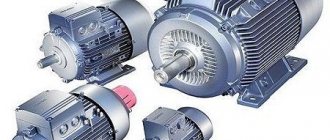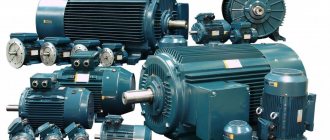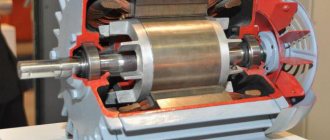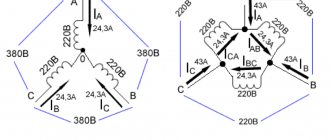In electrical engineering the term armature
denotes a component of an electric machine [1] with a working winding, as well as a moving part of the magnetic circuit [2] of an electromagnet and relay. With regard to physical movement, parts of electrical machines are divided into moving (rotor) and stationary (stator). GOST 27471-87 (Rotating electric machines. Definitions) defines an armature as part of a DC commutator machine or an AC synchronous machine in which an emf is induced and a load current flows. In accordance with this, the armature of a rotating electrical machine can be both its rotor and stator. A simple rule widely used in practice defines an armature as a winding of a machine through which the mains current flows when it is operating in motor mode, and when operating in generator mode the voltage is removed from it. So, in a commutator DC machine, the armature will be the rotor (designs of brushless DC motors are also known, where the armature is the stator, see photo), in a synchronous AC machine, in most cases, the stator (with the exception of some designs of low-power machines, where the output tension is removed from the rotor through brushes); the term is not used in relation to asynchronous machines (in them, both the stator and the rotor can be considered an armature).
In a DFC, the armature interacts with another component of the magnetic circuit, which creates an excitation field [3] . These can be electromagnets or permanent magnets. [3]. The armature, in turn, contains an electric current conductor oriented, to a first approximation, perpendicular to the magnetic field and to the direction of movement, rotation or linear movement.
To search for open, short-circuited and short-circuited turns, a device for checking armatures (APY) can be used - a transformer with an open magnetic circuit.
In the Service, Maintenance, Tuning , answer the question How is the rotor different from the armature? asked by the author Yergey XXX, the best answer is You see, dear Sergey XXX, the question, as I understand it, has a trick. Most likely NOTHING!! ! This is the same name for a part of an electric current generator or electric motor. There’s just one thing I don’t understand - ARE SUCH QUESTIONS NEEDED in FIG?? ? Do you really need answers to these questions? ? Or I just wanted to flirt (make fun). Source: Many years of experience!!
What is the difference between synchronous and asynchronous motor?
The motor is called asynchronous because the rotation frequency of the stator magnetic field does not coincide with the rotation frequency of the rotor. ... In a synchronous motor, the rotation frequency of the stator magnetic field and the rotor rotation frequency are the same.
Interesting materials:
When is Oge in 2022? When is Easter in 21 what date? When are crosses baked in 2022? When do they change the time in Russia in 2022? When will the Ob River go to Surgut in 2022? When is Easter celebrated in 2021? When is forgiveness day in 2022? When is winter farewell in 2021? When is Radonitsa for Catholics in 2022? When is Radonitsa celebrated by the Orthodox in 2022?
From simple inventions to the electric motor
After a number of his discoveries, J. Henry made a magnetic circuit with a coil, which was installed horizontally, like the beam of a laboratory scale. When the armature swung, the contacts attached to the ends of the rocker touched the terminals of two galvanic cells, which fed the coil with currents of different directions. While swinging, the rocker was attracted to two permanent magnets that were part of the system.
The installation could operate continuously, imparting 75 swings to the armature per minute. This is how one of the first designs of a reciprocating electric motor arose. And turning it into a rotational motion engine at that time was not difficult. It is worth noting that machines with reciprocating motion were not popular at that time, since electric motors with a rotating armature were considered technologically more convenient.
Later came the era of three-phase alternating current. The rotating components of an AC motor are no longer called an armature. The rotating magnetic field began to be called a vortex, and the rotating part - a rotor. However, in DC machines the terminology has been preserved. The armature rotated, and the pole piece was called a shoe.
Today, multiphase linear electric motors for monorail trains are becoming widespread. A tightly attached monorail is used as a rotor, and windings that are installed on the magnetic core of fast-moving electric trains serve as the stator.
The company ZAO PromElektroRemont has all the necessary certificates for the provision of such work as:
- Repair and rewinding of electrical equipment;
- Repair of welding transformers;
- Repair of pumps, including deep ones;
Other events
Best answers
Elektroburatino:
You see, dear Sergey XXX, the question, as I understand it, is a tricky one... Most likely, NOTHING!! ! This is the same name for a part of an electric current generator or an electric motor... I just don’t understand one thing - WHY ARE SUCH QUESTIONS NEEDED?? ? Do you really need answers to these questions? ? Or I just wanted to flirt (make fun).
Larisa Dementieva:
Is it true? The rotor is something that is in rotation, and the anchor forces it to remain in stagnation.
armature in DC motors, rotor in AC motors.
This is the name of one part that rotates inside the stator. Difference. There is no winding on the rotor, but there is one on the armature.
The rotor in DC electric machines is called an armature.
Amir Kstaubaev:
The rotor is the entire rotating part of the electric motor. motor (from the beginning of the motor shaft to the end of the shaft. And the armature is that part, round, where exactly the winding with steel plates is where the EMF is formed. (The rotor is the entire rotating part of the electric motor. Entirely. And the armature is the part of the rotor where the electric winding is located engine in which the EMF is induced. Here in this photo, the armature along with the windings is indicated by the number four.)
Anatoly Lapshov:
unfortunately, the armature and the rotor are completely different parts, for some reason they don’t put a rotor on the electromagnet, and in non-rotor asynchronous motors there is a short-circuited armature, also now they call a die, but is it possible to cut a thread with a die without a tool? Yes, of course, people who studied in at the crossings it seems to them that all the same educated people were kicked out
Working with an ohmmeter
Sincere could occur due to the loss of electrical contact in one of the lamellas. To measure resistance, it is recommended to place probes on the side of the current collectors. While rotating the motor shaft, observe the dial readings. The screen should show zero values. If the numbers slip by even a few ohms, then this indicates carbon deposits. When an infinite value appears, an open circuit is judged.
Regardless of the results, you should next check the resistance between each adjacent lamellas. It should be the same for each measurement. In case of deviations, you need to inspect all the connections of the coils and the contact surface of the brushes. The brushes themselves should wear evenly. If chipped or cracked, they must be replaced.
The coils are connected to the core by wiring that may have come loose. Solder often does not withstand shock from drops. In a starter, the current through the contacts can reach 50A, which leads to burnout of poor-quality connections. External inspection determines the location of damage. If no malfunction is found, then measure the resistance between the lamella and the coil itself.
Types of converters
Why is it so important to consider the types in order to understand how the stator of an electric motor differs from its moving part. The thing is that electric motors have a lot of design features, the same applies to generators (these are converters of mechanical energy into electrical energy, electric motors have the opposite functionality).
So, electric motors are divided into AC and DC devices. The former, in turn, are divided into synchronous, asynchronous and collector. For the former, the angular speed of rotation of the stator and rotor are equal. For the latter, these two indicators are unequal. In collector types, the design contains a so-called frequency converter and the number of phases of a mechanical type, which is called a collector. Hence the name of the unit. It is he who is directly connected to the windings of the motor rotor and its stator.
How to “revive” a faulty device?
Repair of the electric motor armature begins only after full confidence in the malfunction of the unit. Scratches and chips on the lamellas are removed by circular groove of the surface. Carbon deposits and soot can be removed with cleaning agents for contact electrical connections. Broken bearings are repressed and replaced with new ones. It is important to balance the shaft during assembly.
Rotation should be easy and without noise. Damaged insulation is restored; ordinary electrical tape can be used. It is better to solder connections that cause suspicion. If there are problems with the armature coils, it is recommended to resort to rewinding, which you can do yourself.
Anchor
The electrical engineering term armature usually refers to one of the parts of electrical machines that have windings. However, this term may also refer to the moving part of the magnetic circuit of a relay or electromagnet. In electric machines, the armature can be either a stator or a rotor. It all depends on the circumstances. GOST 27471-87 (Rotating electric machines. Definitions) gives the armature this designation
The part of a DC commutator machine or an AC synchronous machine in which an emf is induced and a load current flows.
Typically, in practice, the concept of armature refers to the part of the electric motor through the windings of which the electric current of the network flows during operation. That is, the armature is that part of the electric motor to the windings of which power is connected (working winding). For a generator, the armature means that part from which the generated voltage is removed. For example, in a brushed DC motor the armature is the rotor. And in a brushless DC motor, the armature will be the stator. For synchronous alternating current generators, most often the armature is the stator. Although in some low-power generators, the armature is a rotor from which the generated voltage is removed through brushes.
DC motor armature
An example of an armature is most rotors from motors for inexpensive hand-held power tools. Because in such tools the electric motors are commutator. That is, there is a collector on the rotor, to which voltage is supplied using graphite brushes. In other words, all rotors with commutators are armatures. However, the commutator should not be confused with the slip or slip rings located on the rotor of some electric machines. Slip rings have a continuous, uniform circle arrangement. The collector consists of many plates - lamellas, isolated from each other.
How is a fault diagnosed?
Checking the motor armature begins with identifying the fault itself. Complete failure of this unit occurs due to scattered commutator brushes, destruction of the dielectric layer between the plates, and also due to a short circuit in the electrical circuit. If there is sparking inside the device, it is concluded that the current collectors are worn or damaged.
Sparking of the brushes begins due to the appearance of a gap at the point of contact with the commutator. This is preceded by a fall of the device, a high load on the shaft when jammed, as well as a violation of the integrity of the solder on the winding terminals.
A malfunction on a running electric motor manifests itself in typical conditions:
What is a rotor
A rotor, also sometimes called an anchor, is a moving, that is, rotating part in a generator or electric motors, which are widely used in household and industrial appliances.
If we consider the rotor of a DC motor or a universal commutator motor, then it consists of several main components, namely:
- Core. It is made of many stamped thin metal plates, insulated from each other by a special dielectric or simply an oxide film, which conducts current much worse than pure metal. The core is made up of them and is a “layer cake”. As a result, electrons do not have time to accelerate due to the small thickness of the metal, and the heating of the rotor is much less, and the efficiency of the entire device is higher due to reduced losses. This design solution was made to reduce Foucault eddy currents, which inevitably arise during engine operation due to magnetization reversal of the core. The same method of dealing with them is used in AC transformers.
- Windings Copper wire, coated with varnish insulation, is wound around the core in a special way to prevent the occurrence of short-circuited turns, which are unacceptable. The entire winding is additionally impregnated with epoxy resin or varnish to fix the windings so that they are not damaged by vibrations from rotation.
- The rotor windings can be connected to a commutator - a special block with contacts securely fixed to the shaft. These contacts are called lamellas, they are made of copper or its alloy for better transmission of electrical current. Brushes, usually made of graphite, slide along it, and at the right moment electric current is supplied to the windings. This is called sliding contact.
- The shaft itself is a metal rod, at its ends there are seats for rolling bearings; it may have threads or recesses, grooves for a key for attaching gears, pulleys or other parts driven by an electric motor.
- A fan impeller is also placed on the shaft so that the engine cools itself and does not have to install an additional device for heat removal.
It is worth noting that not every rotor has windings, which, in essence, are an electromagnet. Instead, permanent magnets can be used, as in brushless DC motors. But an asynchronous motor with a squirrel-cage rotor does not have windings in the usual form; instead, squirrel-cage metal rods are used, but more on that below.











